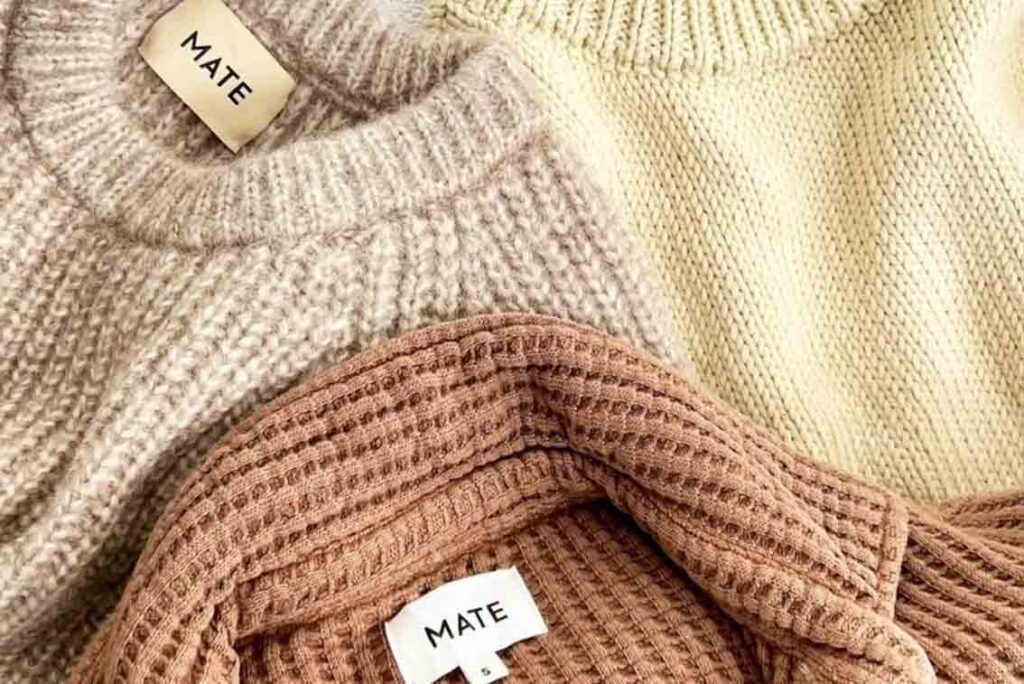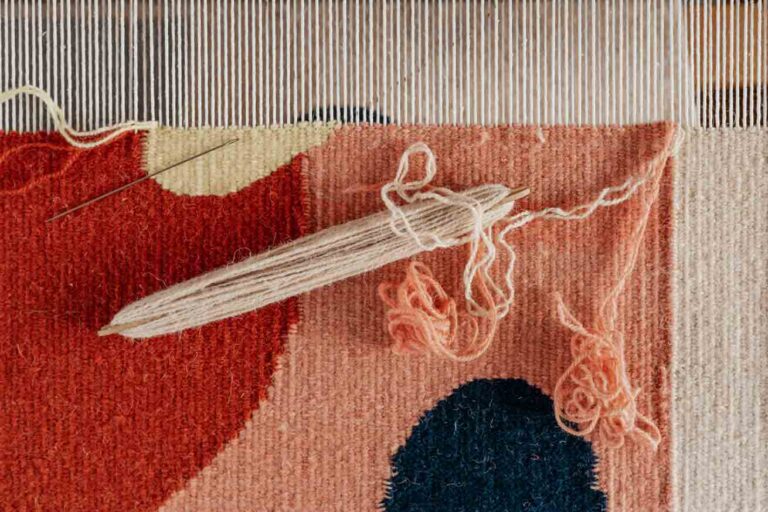A tale of two t-shirts: the first will take up to 200 years to decompose. The second will take up to 2700 liters of water to make.
That first t-shirt is made of polyester, a synthetic fabric. And the second? Cotton.
When comparing natural vs synthetic fabrics, it’s easy to assume that natural is better. However, the story is more complicated than it may seem. Both fabrics have their benefits and drawbacks, making it confusing to figure out what you’re wearing, and what you should be wearing.
But, it doesn’t have to be complicated. Learning about natural vs synthetic fabrics — how they’re made, their benefits and concerns, and learning to differentiate between the best options — can give you a lot more control over your choices.
If you want to understand what exactly a natural vs synthetic fabric is, the pros and cons, and the best options for both, read on.

What are Natural and Synthetic Fabrics?
Natural fibers are made from animal or plant-based fibers. Examples include cotton, wool, linen or silk.
Synthetic fibers, on the other hand, are man-made and created using different chemicals. Examples of these include polyester, nylon, and lycra.
While natural fabrics have been around as long as humans have been wearing clothes, synthetic fibers have only been around since the 1930’s, when they were first introduced to make hoisery that was stretchy and strong.

Synthetic fibers are cheap to produce. So, following the economic depression of the 1930s, they became a popular choice. Now, synthetic fabrics are found virtually everywhere you look. In fact, 62% of all fibers produced today are synthetic.

What are Natural and Synthetic Fibers Made From?
The origins of natural and synthetic fibers are two very different tales.
What Are Synthetic Fibers Made From?
Synthetic fibers are crafted from chemicals known as polymers, which are derived from fossil fuels such as coal and crude oil and are similar to plastics.
After chemical processing, the polymers are extruded into threads. Common synthetics include polyester, nylon, and acrylic.
What are Natural Fibers Made From?
Natural fibers come from plant fibers and animal products. Common natural fibers include cotton, sheep’s wool, linen from the flax plant, and silk from silkworms. The fibers are carefully cleaned to be turned into yarn.
How are Natural and Synthetic Fabrics Made?
Once the synthetic or natural materials have been made into fibers, those fibers are then twisted together to create yarn. Then, machines weave or knit them into fabrics.
Practical Qualities of Natural vs Synthetic Fibers
Cost and environmental impact aren’t the only things fashion brands look at when choosing between synthetic and natural fibers. Both have benefits and drawbacks that must be considered when choosing which is right for a garment.
Natural Fiber Benefits
- Breathability: Natural fabrics allow air circulation through the garment, especially important for garments like underwear.
- Warmth: Fabrics like wool are ideal for winter clothing.
- Moisture-Wicking: Natural fibers keep the body dry from sweat or other moisture.
Natural Fiber Cons
- Absorbent: While this can be a benefit, it also means natural fibers aren’t water resistant.
- Harder to care for: Caring for natural fibers like silk, linen, and wool requires more steps, as they may need to be washed carefully and air-dried.

Synthetic Fiber Benefits
- Water Resistance: Synthetics excel in resisting water, making them a top choice for a lot of outdoor gear.
- Stretchiness: Their elasticity provides comfort and flexibility, especially useful for athletic clothing.
- Wrinkle Resistance: Synthetic fabrics are often wrinkle-free.
- Easy to Care For: Synthetics are low-maintenance and can withstand many rounds of washing.
Synthetic Fiber Cons
- Not breathable: Unlike natural fibers, synthetics can stick to the skin and trap in heat.
- Not heat resistant: Because synthetics are essentially plastic, they can melt and become deformed if exposed to too high of heat.
Summary: Differences in Natural & Synthetic Qualities
Synthetic fibers can be low-cost, water-resistant, stretchy, and easy to care for. They’re great for athletic and outdoor clothes.
Natural fibers are breathable and moisture-wicking, making them ideal for undergarments and temperature regulation (wool can provide warmth, while linen and cotton can be light and airy).

Natural vs Synthetic: Which Is More Sustainable?
It’s easy to assume that natural fibers, which come from nature, are more sustainable. However, it’s not so black and white.
Are Natural Fabrics Sustainable?
Natural fibers have potential to be sustainable, as they come from natural sources and biodegrade. However, issues that can challenge this include:
- Water consumption: crops like cotton consume a lot of water. Silk also requires large amounts of water in production.
- Monoculture ecosystem impact: The high demand for natural fibers natural ecosystems to be ruined by over producing a single crop.
- Pesticide usage: Ecosystems and farmers are also harmed by the heavy use of pesticides for certain crops.
- Methane production: Animals like sheep and cows that are used for wool and leather produce large amounts of methane, which impact global warming.

Are Synthetic Fabrics Sustainable?
Because synthetic materials don’t rely on growing plants or using animals, they can be less water-intensive and vegan. However, they’re linked to their own array of issues:
- Fossil fuel reliance: Synthetic materials are made from fossil fuels which release greenhouse gases, like carbon dioxide, and exacerbate global warming.
- Non-biodegradable: Synthetic fabrics don’t decompose like natural fibers, causing landfill pollution.
- Microfiber pollution: When synthetics are washed, tiny pieces called microfibers fall off and enter the water stream. This harms everything from the oceans to the soil where crops are grown.
- Toxic dyes: Specific dyes must be used to adhere to synthetic fabrics, which often contain toxic chemicals, like Azo dyes.

Sustainability Key Takeaways.
In sum, natural fibers can waste a lot of water, harm the ecosystems where they’re grown, and increase global warming through producing methane.
Synthetic fibers don’t biodegrade which creates waste and microfiber pollution, rely on fossil fuels, and use harsh chemicals.
So, with significant drawbacks to both options, what do we do? Luckily, there are ways to choose the best and ditch the rest.

3 Ways to Choose the Most Sustainable Fabrics
Fabrics, no matter their origin, can have dirty secrets in how they’re made. But, there are better options for both synthetic and natural fibers. Here’s what to look for to choose the best.
1. Choose Low-Impact Natural Fiber Clothing
Natural fabrics like linen and hemp have a lower environmental footprint.
They don’t require as much water as cotton and are a zero-waste crop, meaning the entire crop is used.

2. Look for Certified Organic Natural Fibers
Organic certifications for natural fabrics, like GOTs, ensure fair trade practices are used and harmful pesticides are avoided. Mate the Label is an example of a brand that uses organic fabrics.
3. Try recycled synthetic fabrics
Recycled synthetic fabrics take post-consumer waste, like old water bottles and used fish nets, or old textiles, and turn them into new fabrics. This means less virgin resources are used, and waste is picked up in the process. Brands like Rothy’s use these recycled materials.

What about Semi-Synthetic Fabrics?
While we’ve been talking about fabrics made from natural or synthetic fibers, there’s actually one more option that exists in between the two: semi-synthetics.
Semi-synthetics are made in a similar process to synthetic fibers, but, like natural fibers, they are derived from plant cellulose instead of petroleum and coal.

Semi-Synthetic, Semi-Sustainable?
One such common semi-synthetic fiber is bamboo. Bamboo is often viewed as a sustainable plant option, due to qualities like rapid regrowth, natural regeneration, and low water requirements.
However, just because it’s made from natural sources doesn’t immediately make it sustainable.
Bamboo, for example, is most commonly seen as a fabric called rayon. This semi-synthetic uses harsh chemicals like caustic soda and carbon disulfide, and creates excess waste in the process.

Sustainable Semi-Synthetic Options
Thankfully, some semi-synthetic fabrics are making strides towards sustainability.
For example, bamboo lyocell employs a closed-loop process that reuses 99% of the chemicals required for production, significantly reducing waste and environmental impact. Boody is one such brand that uses this material.
Wrapping Up
Building a sustainable wardrobe doesn’t have to be limiting. Comparing natural vs synthetic fibers may not be straight-forward, but understanding the pros and cons can help us support more sustainable options and avoid fast fashion and harmful practices.
FAQ
What are synthetic and natural fiber examples?
Natural fiber examples include cotton, hemp, linen, wool, and silk. Synthetic fabrics include polyester, nylon, acrylic, and lycra.
What are the differences between synthetic fibers?
- Acrylic Fibers: Acrylic fibers are synthetic polymers made from acrylonitrile. They are known for their softness and warmth, often mimicking the feel of wool. Key characteristics of acrylic fibers include resistance to sunlight and mildew. They are commonly used in sweaters, scarves, and other cold-weather clothing due to their insulating properties.
- Polyester Fibers: Polyester fibers are derived from petroleum-based chemicals, and they are regarded for their resistance to wrinkles. They are used in various clothing items, from shirts and blouses to dresses and activewear. Polyester is known for its ability to retain its shape and resist moisture, making it a common choice for sportswear.
- Nylon Fibers: Nylon is a synthetic polymer that was developed as a substitute for silk during World War II. It’s known for its strength and resilience. Nylon is made from petrochemicals and is commonly used in hosiery, stockings, lingerie, and activewear due to its durability and ability to provide a comfortable fit.







